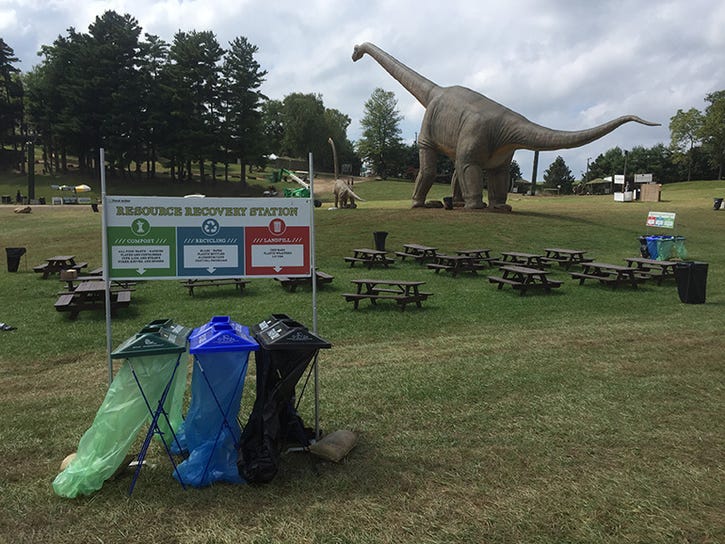Summer Music Festivals Set Sights on Waste Diversion
Several festivals across the country have committed to making waste diversion part of their events.

Summer music festivals bring out huge crowds of people who celebrate, revel and generate tons of waste. To make these multiday events more sustainable, across the country, several festivals have committed to making waste diversion part of the package.
Ann Arbor Summer Festival
In Michigan, the Ann Arbor Summer Festival is a 21-day event, with about 175 scheduled events held across the University of Michigan campus and in downtown Ann Arbor in June and July. The festival serves about 80,000 people. It has been running for 36 years, and for the past two years, the focus has been on moving toward zero waste.
In 2018, the Ann Arbor Summer Festival achieved a 53 percent diversion rate. For 2019, the goal was 75 percent. The festival surpassed this year’s goal by achieving a 81 percent diversion rate, says James Carter, programming and operations manager for the festival.
The zero waste initiative launched last summer and included onsite community conversations and educational programs focused on explaining the importance of waste diversion. For this year’s event, the festival stepped up its efforts by adding 13 stations with three-stream waste collection and mandated that vendors use compostable, reusable or recyclable products.
To promote the zero waste initiative to attendees, organizers shared the message via a press release, social media posts and an email blast before the festival began. They also encouraged attendees to refrain from bringing plastic water bottles to the shows. The city of Ann Arbor provided two water stations on the festival site through its A2H2O program. Carter notes that the number of water bottles collected reduced by more than 3,900 this year.

In the event’s Festival Footprint Learning Center, the goal was to inspire attendees to make waste diversion a part of their daily lives through educational talks, programs and art-making activities.
Collaboration has been key for the project. Partners such as Toyota, which has been supporting the festival for the past 11 years, as well as the University of Michigan, the city of Ann Arbor and other local community organizations have provided funding, equipment, programming, training and other needed services.
Although the festival is headed in the right direction, the move toward zero waste has not been without its challenges. For example, from the 200 volunteers the festival usually recruits, it needed about three times as many volunteers for this year’s festival, says Carter.
It's moving in the right direction, having exceeded the goal for 2019. “We learned a lot and hope to hit the 90 percent diversion rate for 2020,” says Carter.
“Our intention is to try and become a model for other groups, other festivals in the region and maybe even the country and show them what we’ve done,” says Carter. “We’re not there yet, but that would be an ultimate goal.”
Zero Waste Event Productions
In Ohio, Zero Waste Event Productions has made festival waste diversion its business model. The company’s goals are to divert more than 90 percent of festival waste from landfill, while also educating attendees about the importance of recycling and composting. The staff does onsite sorting, as well as coordinate with local recyclers and composters to ensure all of the festival’s waste is properly processed.
Founded in 2011, under Rural Action’s Zero Waste Program, the efforts began with the local, four-day Nelsonville Music Festival, which has achieved zero waste status for the past four years, says Tyler Bonner, chief executive officer for Zero Waste Event Productions.
The company has its own custom sorting equipment, which includes a portable conveyor belt. While festival organizers may balk at the idea, Bonner says that making the conveyer belt prominent increases results.
“A lot of times they try to hide us behind the stage or kind of in the background somewhere, but we have seen that if our operation is visible and attendees can see the work that is being done, that every bag of material is being sifted through to ensure that as much recycling is pulled out as possible, they really pay a lot more attention to picking up after themselves and making sure to use the proper bin when they are discarding their material,” says Bonner.
Bonner also encourages organizers to make announcements from the stage about progress toward the zero waste goal throughout the day. Not only does it get people excited but serves as a reminder to think twice about where people are putting their trash.
Additionally, while it may seem intuitive, one thing that Bonner sees time and again is the need for festivals to make waste stations more visible and to pair landfill and recycling bins wherever they are located.
With the understanding that going zero waste might take some time, Zero Waste Event Productions helps its clients to implement a multiyear strategy, building on each year’s successes. Staff creates detailed infographics after each event to showcase the diversion data and suggest ideas for the future.
According to Bonner, the investment in waste diversion is worth it, especially for music festivals, because demonstrating a commitment to sustainability can be a selling point for their patrons.
“I think they’re realizing that, especially millennials, which I think are a large part of the population for music festivals. They have been shown to really value sustainability and waste diversion,” says Bonner.

Outside Lands
In San Francisco, Outside Lands (August 9-12), which features art, food, wine and music in Golden Gate Park, has been striving to make its festival a zero waste event.
Outside Lands partners with Clean Vibes, a company that focuses on responsible onsite waste management of outdoor festivals and events. Clean Vibes oversees the waste diversion and cleanup process and coordinates with local organizations such as Recology to appropriately manage the collected materials.
“We have achieved above 90 percent waste diversion for the past several years, and our goal for 2019 is to continue to achieve more than 90 percent,” says Anna Borofsky of Clean Vibes.
In 2018, Outside Lands captured more than 64 tons of compost, more than 110 tons of recycling and reuse and nearly 16 tons of landfill waste. The total waste produced was about 191 tons. Of that, 175 tons were diverted from the landfill, achieving a 92 percent diversion rate.
Educating festival patrons about how to help keep the waste streams clean is an important part of the waste diversion process. Signage is placed at all waste receptacles, and to further stress the message, Clean Vibes’ waste management-focused volunteers give guidance: “Their favorite line is, ‘It’s probably compost,’” says Borofsky.
Achieving zero waste over several days requires vigilance, commitment and communication. “Comprehensive waste diversion involves every single person onsite at the event—not just the patrons but all of the staff and volunteers,” says Borofsky, who notes that waste diversion has been “front and center” to the mission of Outside Lands since it began in 2008.

Five Points Jazz Festival
In Colorado, the Five Points Jazz Festival is an annual festival that celebrates the history of Denver’s Five Points neighborhood in May. In 2018, the festival collected a total weight of 1.85 tons with a 39.5 percent diversion rate. This year, 2.86 tons were collected with a 46.5 percent diversion rate.
For this year’s event, organizers Denver Arts & Venues partnered with Eco-Cycle and Eco-Products and introduced strategies such as three-stream collection and mandating that vendors use compostable materials.
“We tried a few years back to go three-stream, but because we didn’t mandate compostable materials or have a process for vendors, we didn’t have much success with composting,” says Brooke Dilling, strategic partnerships and community programming specialist of Arts & Venues for the city and county of Denver.
Like Ann Arbor’s festival, organizers also made an effort to cut down on plastic bottles by making water available for free. They brought in two water trees built by Majestic Collaborations and had water dispensers at the various venues.
Dilling notes challenges the festival faced this year. For example, in the late afternoon, despite the city trash cans on the sidewalk being covered, they were forced open, which created contamination in the waste streams.
“Attendees began breaking into these trash cans and shoving whatever they had into them. Additionally, vendor waste was not as clean as desired,” says Dilling.
For next year, the Five Points festival is anticipating bringing more staff to manage the crowds, which were close to 100,000 attendees this year; creating a more streamlined system for removing waste from the bins during the day; and providing more waste diversion education to vendors earlier in the process.
Organizers also are thinking about ways to reuse festival materials. “We’re working to find a nonprofit company to reuse our vinyl and mesh festival banners and make them into cool totes and clutches to sell,” says Dilling.
For other music festivals focusing on sustainability, Dilling offers advice.
“Find local partners that can help you with your efforts and communicate early and often,” says Dilling. “Your festival attendees want you to do this. Thinking through how to make it happen was challenging, but overall it was very rewarding to reduce our environmental impact.”
About the Author(s)
You May Also Like


